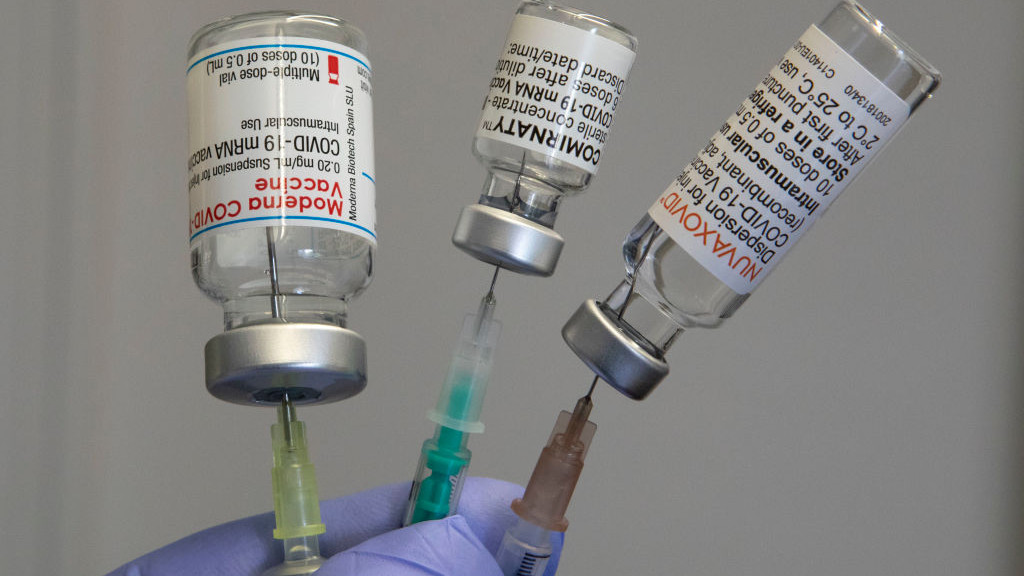As fall COVID-19 surge looms, is it worth waiting for an Omicron tailored vaccine?

Posted Aug 20, 2022 2:59 pm.
Last Updated Aug 20, 2022 3:25 pm.
Anticipation is mounting for Canada to approve an updated version of the COVID-19 vaccine as fall threatens to usher in a new wave of infections.
Earlier this week, British regulators became the first in the world to authorize Moderna’s bivalent vaccine, which protects against both the original strain of the novel coronavirus and the Omicron BA.1 subvariant.
Health Canada is currently reviewing bivalent booster candidates from Moderna and Pfizer-BioNTech, which leaves some Canadians debating whether to wait for the revamped shots or go for a booster now.
With viral circulation projected to pick up as the season changes, some provinces are encouraging people to get a booster of the approved version of the vaccine. For many people, that would mean a fourth or fifth dose of the original formula.
Experts say the extent to which the bivalent vaccines provide additional protection from catching COVID-19 is still being studied, and the cost-benefit analysis of waiting for one depends on the person.
Here’s a look at what we know about the bivalent vaccines, and how they could factor into a fall wave.
WHEN WILL BIVALENT VACCINES BE AVAILABLE?
Health Canada received Moderna’s bivalent vaccine application on June 30, while its British counterpart got the paperwork to start its review earlier that month, spokesman Mark Johnson said in an email. Pfizer filed a submission for its updated shot on July 25.
While the agency didn’t provide a timeline on when these reviews are set to wrap up, Health Canada has already asked vaccine manufacturers to further tweak their bivalent vaccines to target the fast-spreading Omicron BA.4 and BA.5 subvariants “as soon as possible,” Johnson said.
RELATED: ‘Weak spot’ in virus responsible for COVID-19 could mean new treatments: researchers
Canada’s chief public health officer, Dr. Theresa Tam, says Canada has secured a “sufficient” supply of bivalent vaccines if regulators greenlight a rollout.
Infectious disease specialist Dr. Zain Chagla said he expects to see more countries authorize bivalent vaccines in the coming weeks and months, which should give Canada time to integrate the updated shots into its fall immunization campaign.
HOW DO BIVALENT BOOSTERS COMPARE TO THE ORIGINAL VACCINES?
Currently available COVID-19 vaccines are monovalent – tailored solely to the original novel coronavirus. In addition to defending against this earlier strain, the proposed bivalent vaccines were designed to recognize specific mutations in Omicron’s spike protein that make it better at evading immune detection.
These updated vaccines may provide “incremental” added protection against catching Omicron, but the extent remains to be seen, said Tam.
Chagla, an associate professor at Hamilton’s McMaster University, said bivalent vaccines may not be the gamechanger that some have hoped for in curbing the spread of the virus.
As the BA.4 and BA.5 Omicron subvariants gain steam in much of the country, the BA.1-tailored bivalent vaccines might not be that much better than a first-generation booster when it comes to deterring COVID-19 infection, Chagla said.
Emerging research suggests that the protection provided by currently available boosters wanes within six to eight weeks, said Chagla. He expects that bivalent vaccines could extend this period by a few additional weeks _ not months.
“I’m happy to be proven wrong,” he said. “But I don’t know if this is going to reset the clock.”
Both the old and new versions of the COVID-19 vaccines are effective at preventing severe COVID-19 outcomes, he noted.
SHOULD I WAIT TO GET A BIVALENT VACCINE?
The short answer is: it depends.
Provinces have expanded access to fourth – and in Quebec, fifth – doses of the original COVID-19 vaccine with the expectation that COVID-19 cases will spike as temperatures fall.
With the health-care system already stretched to its limits, the priority needs to be boosting those at highest risk of landing in hospital, such as immunocompromised people and older adults, Chagla said.
But as a greater share of the population has gained hybrid immunity, it wouldn’t be unreasonable for low-risk people to wait for the latest version of the vaccine, Chagla said.
RELATED: Pfizer COVID booster dose approved for kids between 5 and 11
Tam encouraged Canadians to weigh both their personal risks and level of COVID-19 spread in their community. But if it’s been more than six months since your last infection or vaccination, you may want to roll up your sleeves for another shot before the cold weather sets in, she said.
“If you waited too long, the wave could be starting,” she said. “Then you don’t derive as much benefit.”
PLAYING THE CATCH-UP GAME
A key challenge in COVID-19 control is that the evolution of the virus has far outpaced the time it takes to develop, test, manufacture, review and roll out a vaccine that can counteract the latest mutation.
“By the time the wave occurs – two to three months – that’s barely enough to scratch the surface of getting a new vaccine,” he said. “There is this catch-up game that’s occurring all the time.”
He hopes the inaugural rollout of bivalent vaccines could provide a “proof-of-concept” that will fast-track this process for future iterations of the vaccine, similar to how the flu shot is tweaked every fall to target variants that are circulating.
“There’s nothing wrong with this being a flu-season-like model, where people just get updated for a certain amount of time,” he said.
While we can’t expect perfect protection from getting sick, we can have the tools to prevent severe illness among the most vulnerable.
“We’re lucky to have this technology.”








